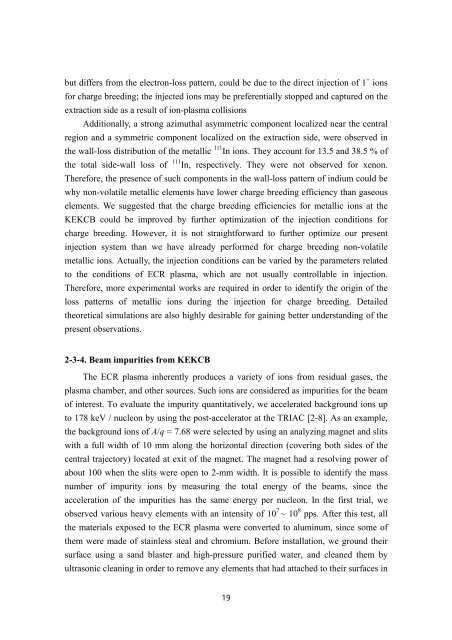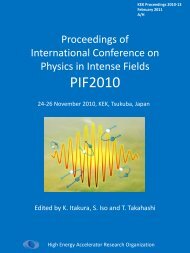TRIAC Progress Report - KEK
TRIAC Progress Report - KEK
TRIAC Progress Report - KEK
You also want an ePaper? Increase the reach of your titles
YUMPU automatically turns print PDFs into web optimized ePapers that Google loves.
ut differs from the electron-loss pattern, could be due to the direct injection of 1 + ions<br />
for charge breeding; the injected ions may be preferentially stopped and captured on the<br />
extraction side as a result of ion-plasma collisions<br />
Additionally, a strong azimuthal asymmetric component localized near the central<br />
region and a symmetric component localized on the extraction side, were observed in<br />
the wall-loss distribution of the metallic 111 In ions. They account for 13.5 and 38.5 % of<br />
the total side-wall loss of 111 In, respectively. They were not observed for xenon.<br />
Therefore, the presence of such components in the wall-loss pattern of indium could be<br />
why non-volatile metallic elements have lower charge breeding efficiency than gaseous<br />
elements. We suggested that the charge breeding efficiencies for metallic ions at the<br />
<strong>KEK</strong>CB could be improved by further optimization of the injection conditions for<br />
charge breeding. However, it is not straightforward to further optimize our present<br />
injection system than we have already performed for charge breeding non-volatile<br />
metallic ions. Actually, the injection conditions can be varied by the parameters related<br />
to the conditions of ECR plasma, which are not usually controllable in injection.<br />
Therefore, more experimental works are required in order to identify the origin of the<br />
loss patterns of metallic ions during the injection for charge breeding. Detailed<br />
theoretical simulations are also highly desirable for gaining better understanding of the<br />
present observations.<br />
2-3-4. Beam impurities from <strong>KEK</strong>CB<br />
The ECR plasma inherently produces a variety of ions from residual gases, the<br />
plasma chamber, and other sources. Such ions are considered as impurities for the beam<br />
of interest. To evaluate the impurity quantitatively, we accelerated background ions up<br />
to 178 keV / nucleon by using the post-accelerator at the <strong>TRIAC</strong> [2-8]. As an example,<br />
the background ions of A/q = 7.68 were selected by using an analyzing magnet and slits<br />
with a full width of 10 mm along the horizontal direction (covering both sides of the<br />
central trajectory) located at exit of the magnet. The magnet had a resolving power of<br />
about 100 when the slits were open to 2-mm width. It is possible to identify the mass<br />
number of impurity ions by measuring the total energy of the beams, since the<br />
acceleration of the impurities has the same energy per nucleon. In the first trial, we<br />
observed various heavy elements with an intensity of 10 7 ~ 10 8 pps. After this test, all<br />
the materials exposed to the ECR plasma were converted to aluminum, since some of<br />
them were made of stainless steal and chromium. Before installation, we ground their<br />
surface using a sand blaster and high-pressure purified water, and cleaned them by<br />
ultrasonic cleaning in order to remove any elements that had attached to their surfaces in<br />
19













